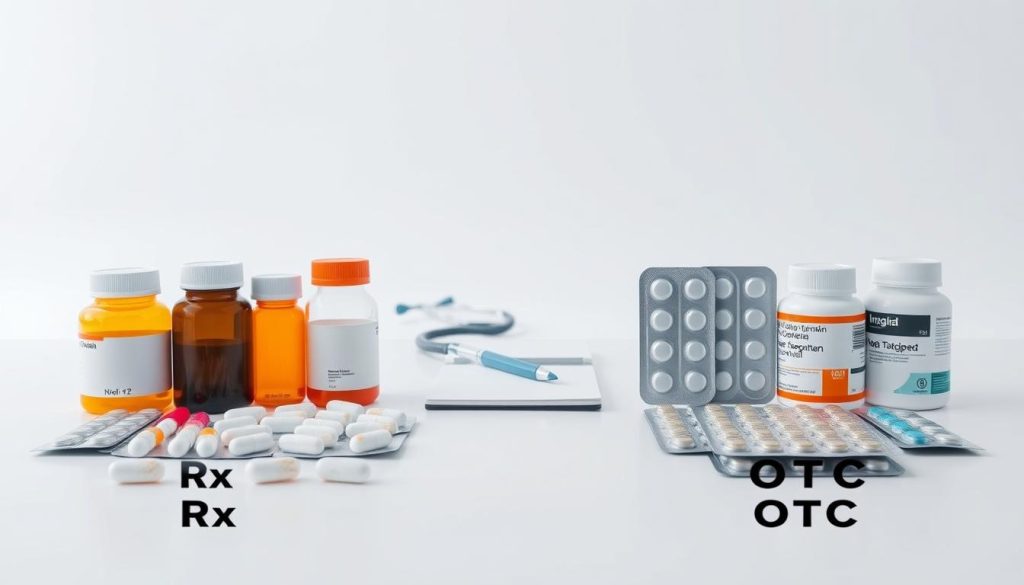Are you aware of the fine line between prescription medications and over-the-counter (OTC) medicines? While both are used to treat various health conditions, the distinction between them is crucial for safe and effective treatment.
The difference between these two categories of medicines is not just about the severity of the condition being treated, but also about how they are regulated, dispensed, and used by consumers.
Understanding the key differences between prescription drugs and OTC medicines can help you make informed decisions about your health. This article aims to clarify these differences and provide insights into their safe use.
Key Takeaways
Table of Contents
- Understanding the regulatory differences between prescription and OTC medicines.
- Learning how to safely use both types of medications.
- Identifying the conditions treated by prescription drugs versus OTC medicines.
- Recognizing the importance of medical supervision for prescription medications.
- Appreciating the role of labeling and packaging in medication safety.
Understanding Medication Classifications
Understanding the different classifications of medications is essential for both healthcare providers and consumers. Medications are broadly categorized into two main types: prescription drugs and over-the-counter (OTC) medicines. This classification determines how a drug is accessed, used, and regulated.
Defining Prescription Drugs
Prescription drugs are medications that can only be obtained with a valid prescription from a licensed healthcare provider. These drugs are typically used for treating conditions that require medical supervision due to their potency, potential side effects, or the need for precise dosage.
Defining Over-the-Counter Medicines
Over-the-counter medicines, on the other hand, can be purchased without a prescription. These medications are considered safe for use by the general public without the need for a doctor’s supervision, provided they are used as directed.
The FDA’s Role in Medication Regulation
The FDA plays a crucial role in determining whether a drug is classified as prescription or OTC. The FDA assesses the safety, efficacy, and potential for misuse of a drug before approving it for use.
This regulatory oversight ensures that both prescription and OTC medications meet stringent standards for public use.
By understanding these classifications, consumers can better navigate the complex world of medications, making informed decisions about their health.
Prescription Drugs vs OTC Medicines: Key Differences
Understanding the distinctions between prescription drugs and over-the-counter (OTC) medicines is crucial for making informed healthcare decisions. These differences are not just about how you obtain the medication but also impact how you use them safely and effectively.
Access and Availability Differences
Prescription drugs require a doctor’s prescription, whereas OTC medicines can be purchased directly from pharmacies or stores without one. This fundamental difference is due to the potential risks associated with prescription drugs, which may require monitoring by a healthcare professional.
Potency and Dosage Variations
Prescription drugs often have stronger active ingredients and varying dosages compared to OTC medicines. The potency and specific dosage of prescription drugs are determined based on the patient’s condition and medical history.
Medical Supervision Requirements
Prescription drugs typically require ongoing medical supervision to ensure they are used correctly and safely. In contrast, OTC medicines are designed for self-use, with instructions provided on the packaging.
Cost Considerations and Insurance Coverage
The cost of prescription drugs can be significantly higher than OTC medicines, but they are often covered by insurance plans. OTC medicines, while generally cheaper, are usually not covered by insurance unless specified by certain health plans.
| Medication Type | Prescription Required | Medical Supervision | Insurance Coverage |
|---|---|---|---|
| Prescription Drugs | Yes | Required | Often Covered |
| OTC Medicines | No | Not Required | Rarely Covered |
How to Identify and Obtain Prescription Medications
To ensure safe and effective treatment, it’s essential to understand how to identify and obtain prescription medications correctly. Prescription drugs are powerful tools in managing health conditions, and their proper use is crucial.
Understanding Your Prescription Label
A prescription label contains vital information about your medication, including its name, dosage instructions, and potential warnings. Always read the label carefully to ensure you’re taking the medication as directed.
Steps to Fill a Prescription
Filling a prescription involves several steps:
- Take your prescription to a licensed pharmacy.
- Verify the pharmacist’s credentials and the pharmacy’s reputation.
- Ensure the medication is correctly labeled and matches your prescription.
Verifying Legitimate Prescription Drugs
To avoid counterfeit drugs, it’s crucial to verify the legitimacy of your prescription medication. Check for the manufacturer’s seal and look for any signs of tampering.
Online Pharmacy Safety Tips
When purchasing from online pharmacies, ensure they are accredited by a recognized authority, such as the National Association of Boards of Pharmacy (NABP). Be wary of sites that offer medications without a prescription.
| Safety Tips | Description |
|---|---|
| Verify Accreditation | Check if the online pharmacy is accredited by a recognized authority. |
| Be Cautious of No Prescription Requirements | Avoid sites that dispense medication without a valid prescription. |
Navigating the OTC Medicine Aisle
With numerous options available, navigating the OTC medicine aisle requires some knowledge to make informed decisions. The variety of products can be overwhelming, but understanding the different categories and how to read labels can simplify the process.
Common Categories of OTC Products
OTC medicines are categorized based on their uses. Common categories include pain relievers, cold and flu medications, antihistamines, and antacids. Pain relievers like acetaminophen and ibuprofen are used to alleviate headaches, fever, and body aches. Cold and flu medications can help manage symptoms like congestion and cough. Understanding these categories helps in selecting the right product for specific needs.

How to Read OTC Drug Facts Labels
OTC drug facts labels provide crucial information about the product, including its uses, dosage instructions, and potential side effects. It’s essential to read these labels carefully to ensure safe and effective use. Look for the active ingredients, warnings, and any specific instructions.
Choosing Between Brand Names and Generics
When selecting an OTC medicine, consumers often face the decision between brand names and generics. Brand name products are often more recognizable, but generic versions can offer the same efficacy at a lower cost. The key is to compare the active ingredients and ensure they match your needs.
Price vs. Efficacy Considerations
While brand name products may be more expensive, the price doesn’t always reflect a difference in efficacy. Generics typically contain the same active ingredients as their brand name counterparts. Therefore, considering both price and efficacy is crucial when making a decision.
When to Choose Prescription Medications
Certain health conditions require the use of prescription medications for proper management. Prescription drugs are often more potent and are used for treating conditions that are beyond the scope of over-the-counter (OTC) medicines.
Chronic Condition Management
Prescription medications play a vital role in managing chronic conditions such as diabetes, hypertension, and asthma. These conditions require consistent and often complex treatment regimens that are typically not achievable with OTC medications.
Treating Acute Serious Conditions
In cases of acute serious conditions like infections, severe injuries, or post-surgical care, prescription medications are indispensable. They provide the necessary therapeutic effect that OTC drugs cannot offer.
When Self-Treatment Is Insufficient
If symptoms persist or worsen despite using OTC medications, it may be a sign that self-treatment is insufficient. In such cases, seeking medical attention and potentially switching to prescription medications is advisable.
Warning Signs to Seek Medical Care
Warning signs that indicate the need for medical care include:
- Severe pain or difficulty breathing
- Symptoms that last longer than expected
- Unusual side effects from medication
As noted by health experts, “The line between OTC and prescription medications is drawn based on the drug’s potential for abuse, safety, and efficacy.”
“The FDA requires prescription drugs to be used under medical supervision due to their potency and potential side effects.”
| Condition Type | Typical Treatment | Level of Medical Supervision |
|---|---|---|
| Chronic Conditions | Prescription Medications | High |
| Acute Serious Conditions | Prescription Medications | High |
| Mild Symptoms | OTC Medications | Low |
When to Safely Use OTC Medicines
Understanding when to use over-the-counter (OTC) medicines is crucial for effective self-treatment. OTC medicines can provide relief for various minor health issues, but their safe use depends on understanding their appropriate applications.
Appropriate Conditions for Self-Treatment
OTC medicines are suitable for treating common, minor health issues such as headaches, colds, and allergies. For instance, pain relievers like acetaminophen or ibuprofen can effectively manage headaches and minor aches.
Preventive Care Applications
Some OTC medicines are used for preventive care, such as vitamin supplements or fluoride toothpaste for oral health. These products can help prevent conditions like vitamin deficiencies or tooth decay.
Managing Minor Symptoms
OTC medicines are designed to manage minor symptoms. For example, antihistamines can relieve allergy symptoms, and antacids can help with heartburn.
When to Stop OTC Use and See a Doctor
If symptoms persist or worsen, it’s essential to stop using OTC medicines and consult a healthcare professional. For example, if a headache persists despite using pain relievers, it may be a sign of an underlying condition that requires medical attention.
| Condition | OTC Medicine | When to Seek Medical Help |
|---|---|---|
| Headache | Pain relievers (acetaminophen, ibuprofen) | If headache persists or is severe |
| Allergies | Antihistamines | If symptoms worsen or difficulty breathing occurs |
| Heartburn | Antacids | If heartburn is frequent or severe |

In conclusion, OTC medicines are a valuable resource for managing minor health issues, but their safe use requires an understanding of their appropriate applications and limitations.
Safety Guidelines for Medication Use
Medication safety is a multifaceted issue that involves several key considerations. Ensuring the safe use of both prescription and over-the-counter (OTC) medications requires attention to detail and a thorough understanding of the potential risks involved.
Preventing Drug Interactions
One of the most critical aspects of medication safety is preventing drug interactions. This involves being aware of the medications you’re currently taking and informing your healthcare provider about any changes. As the FDA states, “Drug interactions can be a major cause of adverse drug reactions.” Always consult with your healthcare provider or pharmacist before starting a new medication to avoid potential interactions.
Proper Storage and Disposal Methods
Proper storage and disposal of medications are also crucial. Medications should be stored in a cool, dry place, away from children’s reach. When disposing of medications, use a drug take-back program or follow the FDA’s guidelines for safe disposal at home.
Tracking Your Medication Use
Tracking your medication use is vital for safety. This can be achieved by maintaining a personal medication record.
Creating a Personal Medication Record
A personal medication record should include the name of the medication, dosage, frequency, and any allergies or sensitivities. As noted by a healthcare professional, “Keeping a medication record can help prevent errors and ensure that you’re taking the correct medications.”
“A well-maintained medication record is a simple yet effective way to enhance medication safety.”
- List the names of all your medications.
- Include the dosage and frequency of each medication.
- Note any allergies or sensitivities.
By following these safety guidelines, you can significantly reduce the risks associated with medication use and ensure a safer treatment experience.
Understanding Your Medication Options
Prescription drugs and over-the-counter medications serve distinct purposes in maintaining our health. A clear prescription drug definition is essential: these are medications that require a doctor’s prescription due to their potency, potential side effects, or the need for medical supervision.
In contrast, over-the-counter medications are available without a prescription and are generally used for self-treatment of minor conditions. Understanding the differences between these two categories is crucial for safe and effective medication use.
By being informed about the proper use of both prescription and OTC medications, individuals can better manage their health, avoid potential drug interactions, and make the most of the treatments available to them.


